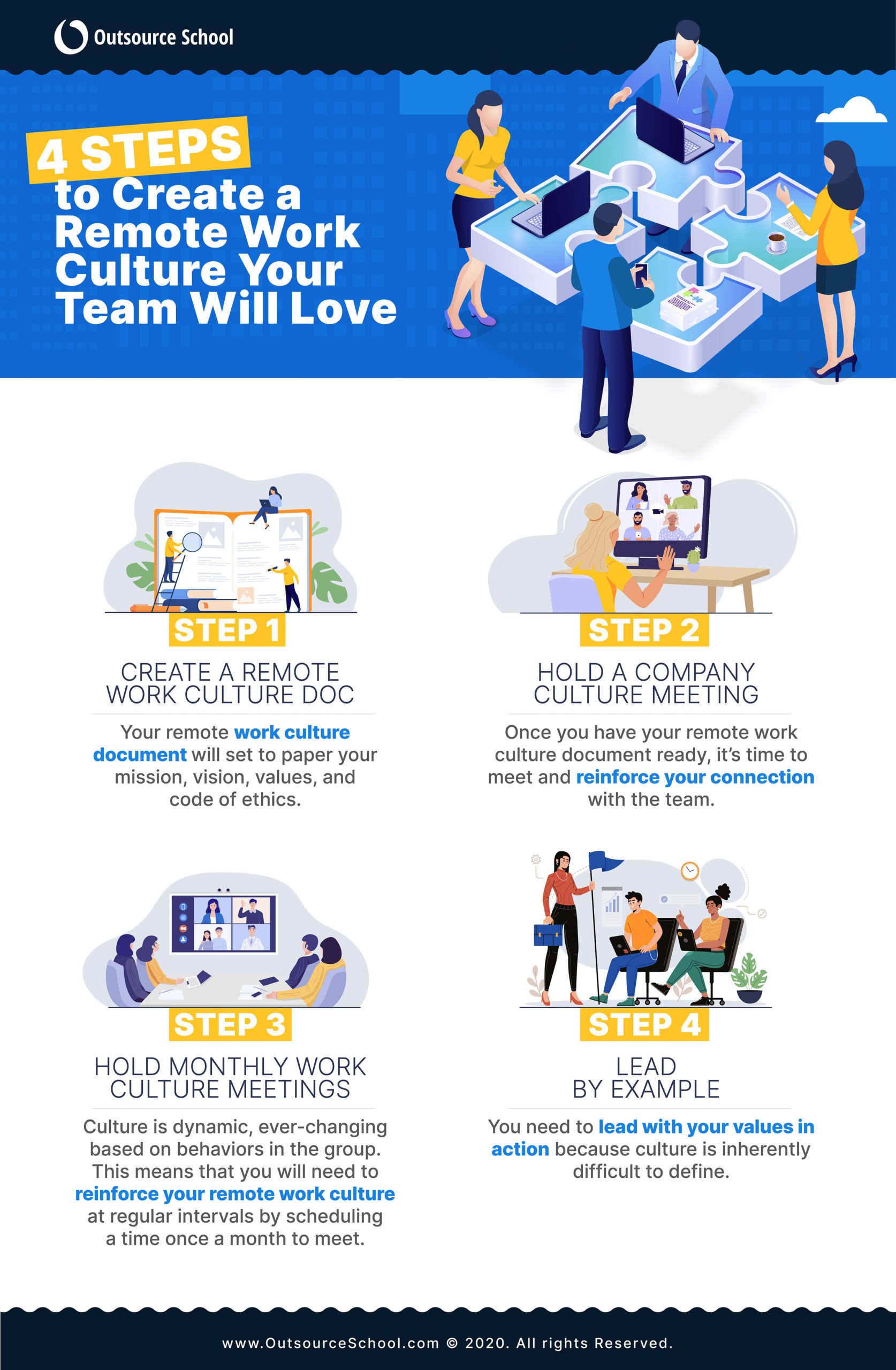Do you have a remote work culture in your business? Maybe you do, but the problem is that it just isn’t working for you or your team or your business overall. Your remote work culture could be better, and you’re ready to take action to make that a reality.
This post is to give you the steps to create a remote work culture that your team will love. Culture is an essential part of every organization, and you have it, whether you know it or not. Company or work culture is what moves people to make a decision about joining one team and not another. It is also a huge part of their decision to stay or leave a business. Company culture develops with or without your guidance, so you really should be at the helm so you can cultivate a remote work culture that serves you. This culture that you create is vital to gaining and maintaining a competitive edge by fostering a work environment that your team wants to come into every day. As you work through the steps to build that better remote work culture, you and your team will enjoy greater clarity, motivation, loyalty, collaboration, and productivity.

(1) Create a Remote Work Culture Doc
Whether you’re hiring remote or not, your business should have a company culture document. This document is there to teach and remind everyone in the company of what the whole team is about. It creates a more tangible form of the abstract concept of culture so that everyone has a more solid guide to refer to whenever they are in doubt or need an attitude adjustment.
Any organization has a greater chance of being successful when they have a work culture that has its foundations in shared beliefs. These beliefs should be strongly held by each member of the team and supported by your strategy as a leader and the structure of work within your business.
With a strong remote work culture, your business will experience powerful improvements in the way work flows. For example, team members will know what to do in any given situation because they are clear on how you would want them to act under different circumstances. They hold the same beliefs as you do, so they know what response you expect as the correct response. They will also know that they are going to be rewarded for putting core values into practice.
So, your remote work culture document will set to paper your mission, vision, and values for starters. This will educate everyone on the basics of what your company is founded on. Your mission statement should concisely explain why the organization exists — its purpose and intention. It supports your vision and expresses the purpose and direction of everyone on the team as well as clients, customers, and other stakeholders. Your vision statement should clearly express how you see your business in its ideal state — the future you want to achieve. It inspires team members to action and challenges them to keep working towards the goal. Your values statement should include the core principles that you hold to guide the business and its culture. These values are the moral compass for the business and everyone working on and in it. In this way, it acts as a standard that everyone checks their actions against. It also therefore directs decision-making.
Now you have a framework of core values to work from as you work on the next part, which is creating a code of ethics. This is simply how you will enforce putting your values into practice. The code is an outline of the procedures that you have in place to make sure that everyone involved in the business upholds its values. Then you can create a section that outlines the behaviors that you will not tolerate within your business.
Remember that you can’t expect any changes in your remote work culture to magically take effect. Change happens gradually and success will depend on how each person embraces the values and ethics and behaves in accordance with them. Each person must be in agreement with the culture for it to effectively guide their attitudes, actions, and decisions.
When you’re hiring remote, remember as well that this document needs to contain elements that speak directly to remote work culture. Consider the unique circumstances that you have within your business as well. Keeping these elements in mind will help you define your culture more clearly in a way that makes complete sense to everyone.
(2) Hold a Company Culture Meeting

Once you have your remote work culture document ready, it’s time to meet with the team. You will need to share the document with everyone else involved in the business because they are very much involved in your business culture. This is not just about demanding compliance with rules and regulations. A company culture only works when everyone is already in agreement in the first place.
At least a week before the meeting, share the document with everyone so that they have time to go over it on their own. Make it clear that they should come to the meeting prepared. This means that they either understand the document or have prepared questions for parts that they need you to clarify. They should also come with thoughts on the different sections and points for discussion.
Begin the company culture meeting by reinforcing your connection with the team. Check in with everyone on a personal level, then check in to see if they’re ready to go over the document. Once you are on the same page with that, give them an outline of what you will cover during the meeting and dive right in.
Go over the document step by step. Ask everyone for any questions that they have about it. Take the time to thoroughly answer questions so that there’s no misunderstanding on any point. The goal will be to avoid future misunderstandings and non-compliance caused by a wrong impression or interpretation of what’s expected. Then ask everyone for their feedback on the section. Take the time to discuss each piece of feedback so that you are sure that you are not misunderstanding. Then you can respond to the feedback and make any needed changes. This can be adjusting parts of the document or adjusting within the team. In some cases, you or a team member may realize that working together is not a good fit. Soon after, make sure that you meet to talk it over. You don’t want to wait too long to get that issue resolved so it’s out of the way.
Always open the discussion up to any final thoughts when you reach the end of the last section. Some team members may have additional questions or feedback. You want to make absolutely sure that everyone is on the same page with you before you all go back to work. If you are going to make any changes to the document, let the team know when the final edition will be available for review. Make it clear at that time that you need them to look it over again and sign off on it. You want to be absolutely sure that everyone is in agreement with you on the culture. It is non-negotiable if you want to create a work environment that everyone loves so you can all be motivated and enjoy clarity, loyalty, collaboration, and productivity.
(3) Hold Monthly Work Culture Meetings
Culture is dynamic, ever-changing based on behaviors in the group. This means that you will need to reinforce your remote work culture at regular intervals. Schedule a time once a month for this. Make it an event that everyone is expected to participate in. Create anticipation for it by demonstrating the value-driven nature of the culture. Everyone will see the meeting as a positive exercise when they are all on the same page with you about the culture and the importance of upholding it.
You should prepare for these meetings with specific points that you want to reinforce. This means being observant in the day-to-day of your business. You need to know what’s going on so that you can take note of any issues and identify which ones are rooted in a misunderstanding of the culture or non-compliance with it.
Begin the monthly culture meeting in much the same way as above, with one element added. As above, reinforce your connection with the team by checking in with everyone on a personal level, then give them an outline of what you will cover during the meeting. Then you want to give everyone the opportunity to meet any new additions to the team. Finally, confirm that everyone is ready to tackle the content, and dive in. Again, make sure to open the discussion up to any final thoughts before you end the meeting.
Note that any new hires should have been directed to review the remote work culture document during their onboarding, before they attend their first culture meeting. This means that you should have already made sure that they have no questions or objections. If they are not in total agreement with you on the document, you should reconsider keeping them on the team.
(4) Lead By Example

Value-driven company culture begins with you and your values being acted out in a consistent manner. You can’t expect team members to behave in the way that you expect them to in your business if you are not setting the example for them. You need to lead with your values in action because culture is inherently difficult to define. You do have that document that outlines behaviors, but culture in itself is an elusive concept. You have to demonstrate it for people to really get a good grasp of it and behave accordingly. Remember, culture isn’t a specific dress code or promotion structure. It’s the atmosphere of shared beliefs in the way that things should be within the company.
You as the business owner, and managers as well, have a very important role to play in encouraging and reinforcing a strong remote work culture. It’s more challenging than perpetuating a culture within a confined office environment because of the physical distance and varying work times. So, you really have to be committed to working on leading by example for it to yield the results that you want to see.
Start taking action to uphold the culture by hiring only those select individuals who share your beliefs. If you are just now creating a purposeful remote work culture or revamping an old one, you may have to restructure your team. You want to end up with people who will thrive in the culture that you are building. Anyone who is not on board a hundred percent will become a hindrance to achieving that goal. Carefully consider the impact that such a person can have, knowing that you may have to replace them for the sake of the business as a whole.
Next, work on developing your onboarding orientation to emphasize your culture to new hires. Then work on training and performance management programs like the monthly culture meeting that will remind everyone of the culture, go over issues, and help everyone to get better and better at practicing the organization’s core values. In line with these programs, you need to develop a rewards program as well to recognize those who embody the company’s values and serve as great examples to everyone.
Final Thoughts
Make your remote company culture fun but productive. In addition to setting clear expectations and rewarding people for working hard, you want to make an effort to avoid micromanaging. You have taken steps to ensure that they hold the same beliefs that you do. Now, let them learn and grow and enjoy the fulfillment that comes from that. Set goals with them as a team to work towards the common vision and the steps in between.
Would you like to know how to be certain who your next hire should be? Or maybe you are having a hard time deciding what parts of your business can be outsourced with virtual assistants, right now. We can help you answer these questions, and help you to discover what new systems you should add to scale your business faster. Set up a free hiring consultation with us at Outsource School today – simply book here!







